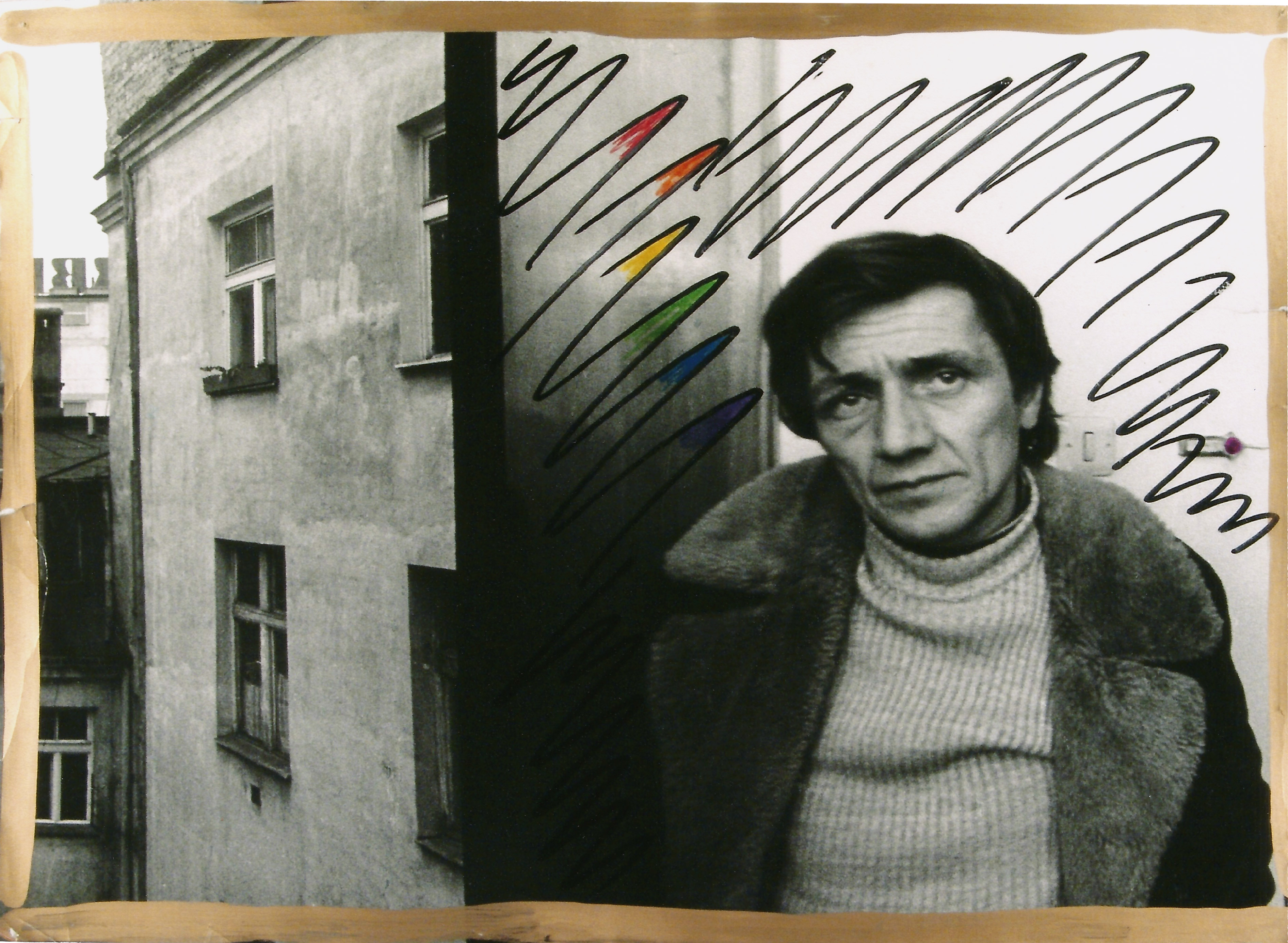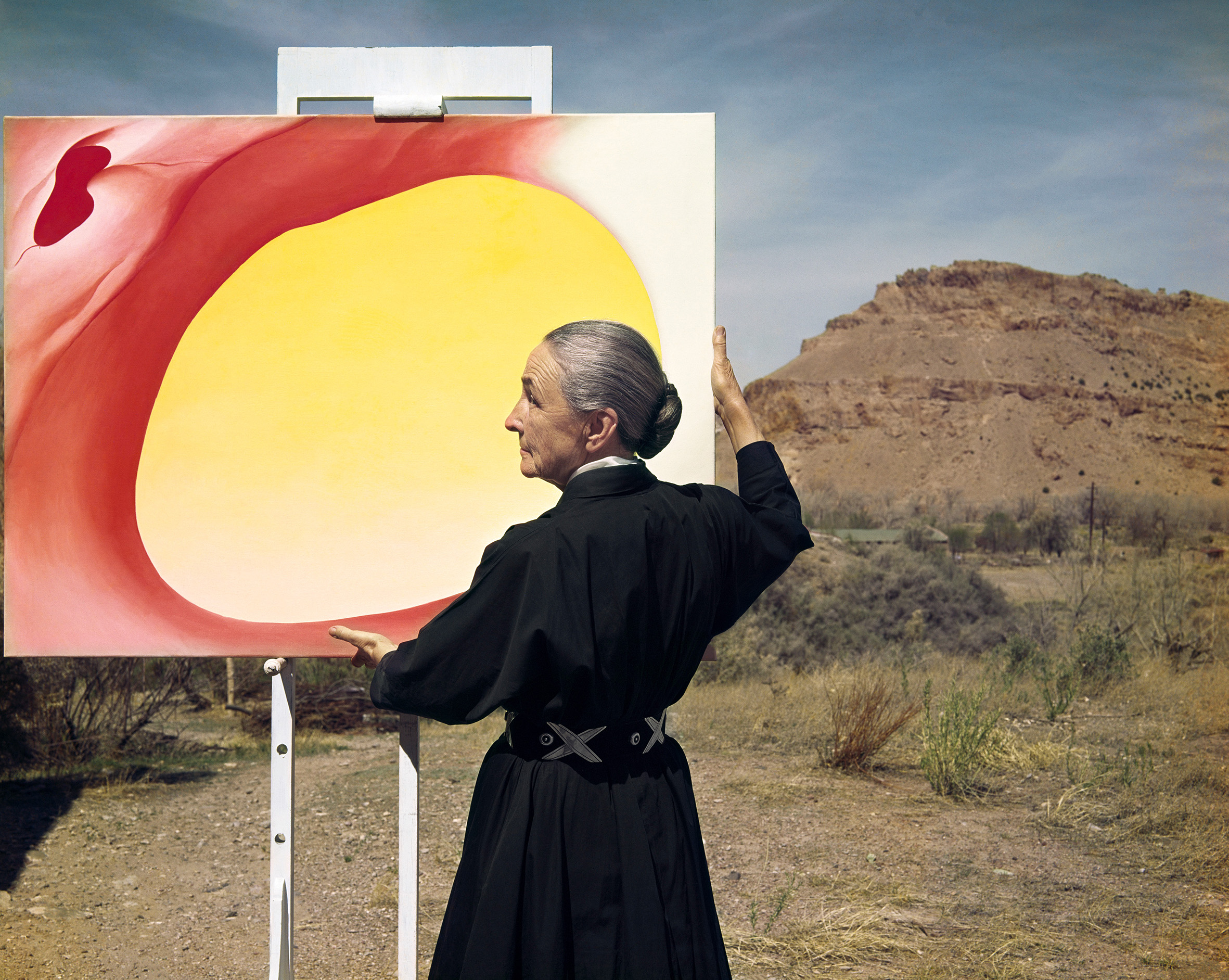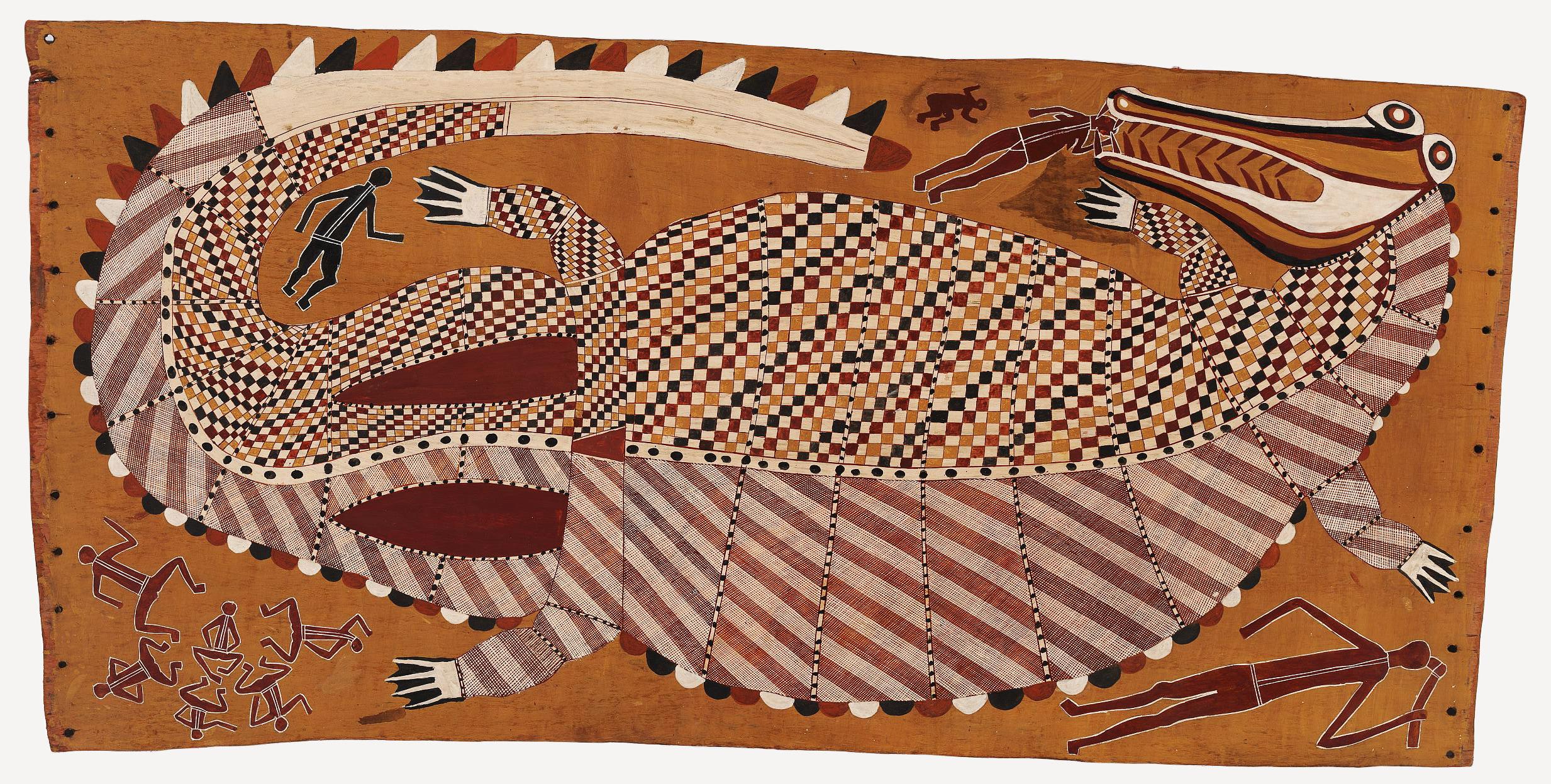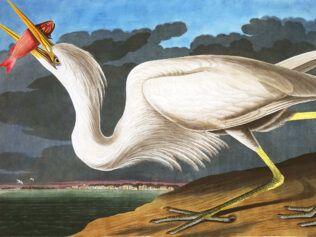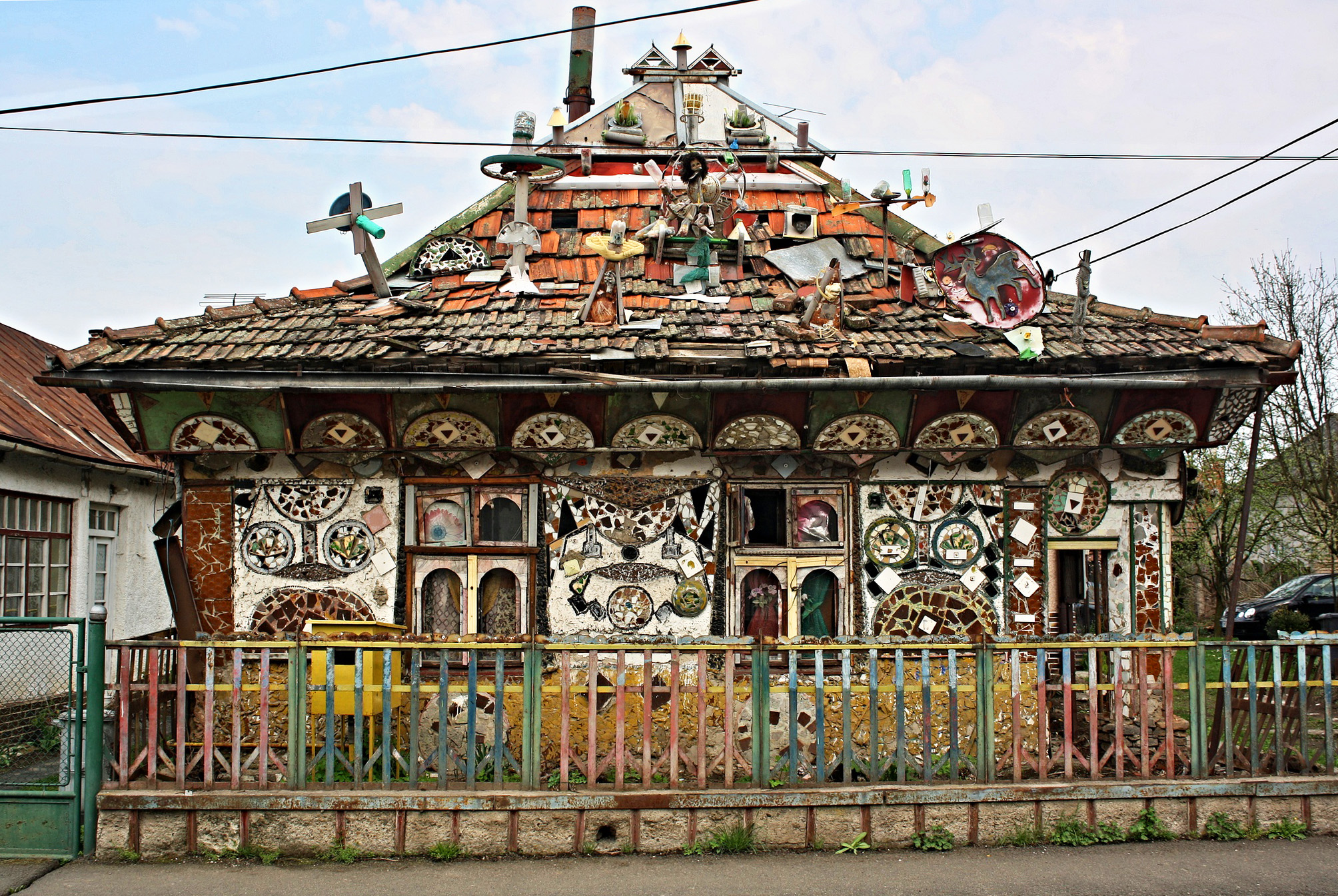
A vagabond, provocateur, opponent of the full-time avant-garde. He sent his art by post, he left a stink in a gallery. According to Julian Przyboś, he was mentally ill. According to some others, he was a great artist. His name was Andrzej Partum.
In fact, nobody knows where Andrzej Partum got his surname from. Did he inherit it from his father? Did he invent it himself? Or perhaps he owed it to the poetic inventiveness of his mother? According to the Latin dictionary, partum caesareum means ‘Ceasarean section’…
All we know is that the ‘King of Krakowskie Przedmieście’, as he was known among the metropolitan bohemia of the 1970s, was born Andrzej Mikiewicz in 1938 in Warsaw. History remains silent about his father, but we know that his mother, Maria Mikiewicz, was a painter. She died in the streets of Warsaw in August 1944, during one of the bombardments, allegedly in front of her children, Karina and, yes, Andrzej. Maria’s brother, the poet Konstanty Mikiewicz, appointed to military service before the war, committed suicide in 1935 in the Officer Cadet Artillery College in Zambrów. Karina, slightly older than Andrzej, died soon after the war in 1946. So little Partum was brought up by his mother’s sister, Krystyna Artyniewicz, an author of children’s theatre plays. Unfortunately, she also bereaved the boy when she died in July 1953 as a result of a lethal mushroom poisoning.
Young Andrzej drifted from one children’s home to another, often sleeping in the stairwells of Warsaw. Let me recall an anecdote here, which he often repeated about his life at that time. One day he found a perfect hiding place in the ceiling of the landing in a tenement’s stairwell. It was quite difficult to climb up there, so when Andrzej finally got there, he was not keen to leave. But one morning he needed to wee. He decided to relieve himself without going down, through the gaps between the boards of the floor. As luck would have it, some militia man was walking past. The future ‘King of Krakowskie Przedmieście’ wetted his cap, revealing his location in the process.
How to get to the Philharmonic
Young Partum had an interest in music. He played the piano, taking advantage of the instrument in the Writers’ House at Krakowskie Przedmieście and using the piano to hide his meagre possessions inside. He also attended classes at the Composition Department of the Warsaw Music Conservatory as an unenrolled student. He also went to a secondary school, but he wasn’t good student material. He was expelled after he publicly demanded the withdrawal of the Soviet armed forces from Poland and the release of Primate Wyszyński. An idiot? More likely somebody who had nothing to lose.
In 1959, at his own expense, Partum printed a poster with the words “Partum in Warsaw!” and pasted it all over the city. A prominent weekly called itd pondered whether “‘Partum’ was in fact a catchphrase, a concept or perhaps signified a person?” In November 1960, a new poster appeared on the walls, informing readers of a piano recital and a “hurl of abstract poetry by Andrzej Partum”. The piano pieces were to be performed by the composer himself, while his poems were to be recited by the one and only Adam Hanuszkiewicz. The poster was printed and pasted everywhere because Partum made a phone call, pretended to be the secretary of the then chairman of the Polish Council of State, Aleksander Zawadzki, and got himself a concert secured at the National Philharmonic. The bureaucrats, standing to attention, printed and distributed the poster, which was only taken down when the surprised Zawadzki found out that his ‘command’ had been followed.
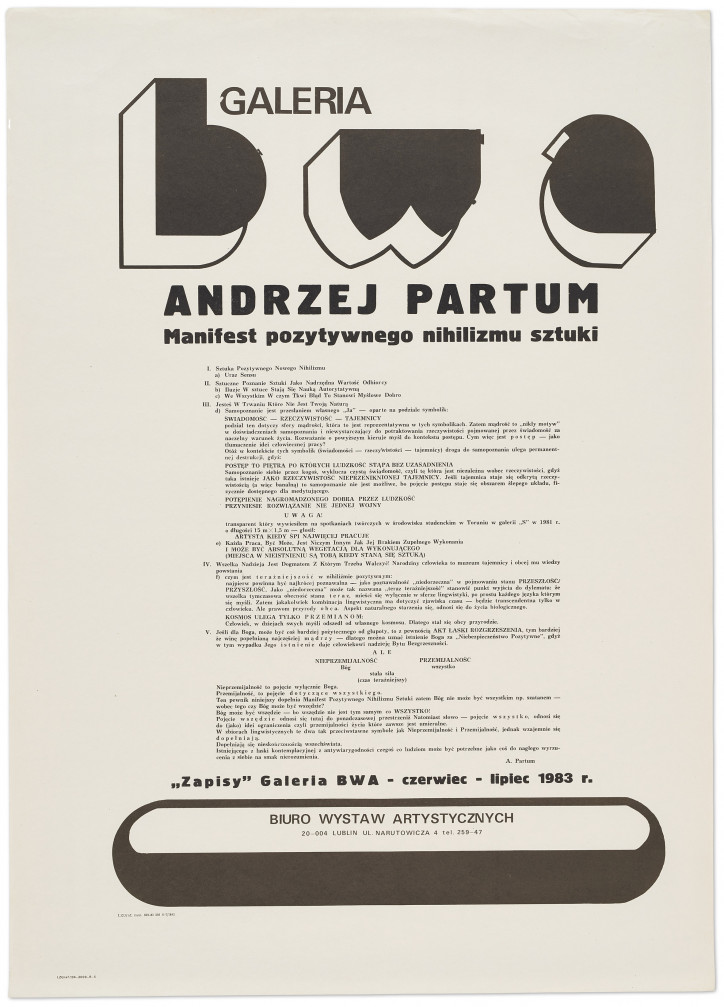
The spirit of semantic ambiguity
In the early 1960s Partum was a regular guest at the Warsaw Hybrydy club, where he played the piano and wrote, most often at 4am. At that time, he thought of himself as a poet. He self-published several poetry books: Frekwencje z opisu [Description Turnouts] in 1961, Powodzenie nieurodzaju (Zwałka papki) [The Success of Bad Harvest (Dumping of Pulp)] in 1965, Osypka woli [Sprinkles of Will] and Tlenek zasobów [Resources Oxide] in 1969. The then literary critics took his writing for gibberish or, at best, as an explosion of graphomania. Julian Przyboś himself decided that Partum was most likely mentally ill. But looking at them from a longer-term perspective, we can say that his poems contained intuitions, which he later developed in his manifestos, filled with an atmosphere of semantic ambiguity.
Garaging a Car
garage entry
inwards
sped up by the car
swallows the tyres’
surface lengths
into rims
of their grooves
(from Frekwencje z opisu)
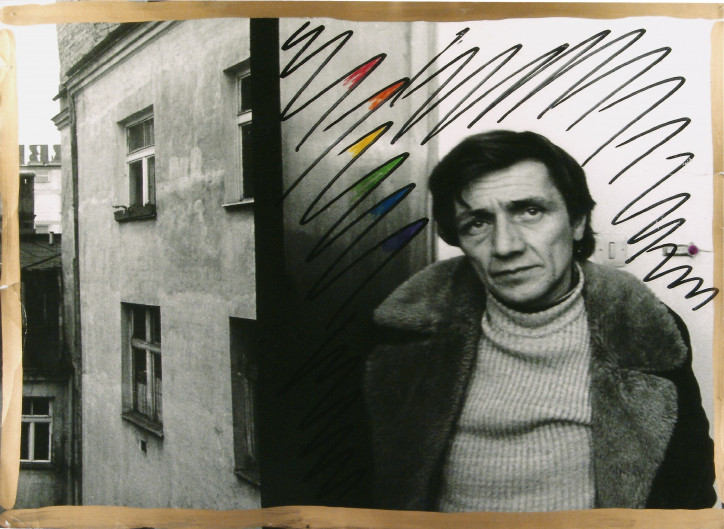
In 1966, Partum met a student of the Fine Art Academy in Łódz, Ewa Frejdlich, who soon became his wife. It was Ewa Partum – if we can believe her – who introduced Andrzej to the issues of contemporary art. Without her competent knowledge, Partum would most likely not have turned in this direction. This influence is noticeable in his late poetry collections. Osypka woli was illustrated with Alfred Lenica’s original distempers. The cover of Partum’s last collection, entitled Partum, published in 1970 and containing solely concrete poetry, was designed by Henryk Stażewski himself.
Manifestos, banners, letters
At that time, Partum lived in a tiny room in the attic of the Polonia hotel, with the entrance in Poznańska Street. In 1971, he turned his minute flat into a Poetry Bureau, which functioned until 1985. The Bureau published works by Partum and by other artists or friendly critics. It also gathered information about current world art and corresponded with artists practising the so-called mail art – popular at the time – such as Dick Higgins, Andrzej Dudek-Dürer, Hervé Fischer, Fred Forest, KwieKulik, László Beke, Robin Crozier, Stanisław Dróżdż and Cavellini. The Bureau also organized private views, shows and artistic actions. It wasn’t just another art organization, though. The Bureau itself was an art phenomenon. Every day, the Poetry Bureau in the form of Partum walked down Krakowskie Przedmieście with a pile of correspondence freshly collected from the post office, to have a longer stopover at the Telimena restaurant across the road from the Dziekanka Gallery, where patrons could exchange the latest news with him or listen to his provocative ad libs.
In the 1970s, apart from running the Poetry Bureau, Partum was mainly busy writing manifestos. In 1970, he created Krytykosystem sztuki [Critique-system of Art], in 1971 – Sztuka Pro/La [The Pro/La Art], in 1972 – Lichwa poezji anomalii modyfikujących w sztuce konceptualnej [Usury of the Poetry of Modifying Anomaly in Conceptual Art] and Zasady sztuki monodycznej [The Rules of Monodic Art], in 1975 – Manifest sztuki bezczelnej [Manifesto of Insolent Art], in 1977 – Manifest zwierzęcy [The Animal Manifesto] and in 1978 – Sztuka jest gównem [Art is Shit] and Teoria sztuki Pro/La [Theory of the Pro/La Art]. In 1980, he also published Manifest pozytywnego nihilizmu sztuki [Manifesto of the Positive Nihilism of Art]. In these proclamations, Partum called for the loosening of man’s link to sacrum, both in a religious and ideological sense. He questioned common-sense perceptions of language anomalies as social evils, more – he pointed out that incongruity can be the source of art or, as he phrased it, ‘injury to sense’. In one of his letters to Dick Higgins, who highlighted the fault in his reasoning, Partum wrote that “lack of understanding for art creates a chance for its continuation.”
“Art is a murder weapon like any other.” (from Manifest sztuki bezczelnej).
“Your cachexy is the trump card of progress.” (from Manifest zwierzęcy).
“The condemnation of the good accumulated by humankind will bring the solution to many a war.” (from Manifest pozytywnego nihilizmu sztuki).
“You are an ignoramus of art and culture.” (from Manifest sztuki bezczelnej).
“An artist works most when he is asleep.” (from Manifest pozytywnego nihilizmu sztuki).
“Obedience in science is the aim of superstition.” (from Manifest zwierzęcy).
“Everything that contains a fault is an intellectual good.” (from Manifest pozytywnego nihilizmu sztuki).
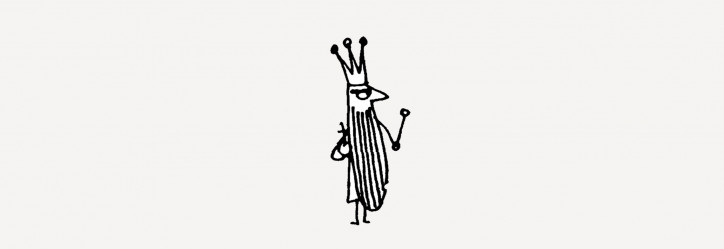
In 1972, as part of the Kino Laboratorium organized by Gerard Kwiatkowski in Elbląg, Partum carried out two actions: “Acupuncture” and “A film does not need a screen”. During the screening of a film by Józef Robakowski, Partum sat on a ladder and pierced the screen with pins, while an assistant held a mirror in front of the projector at such an angle that the image was projected onto the ceiling and the walls of the gallery. This action pointed to the physicality of the film projection itself, as well as the fact that art, just like science, does not necessarily need an audience.
In April 1975, Partum hung a huge banner over Krakowskie Przedmieście, between the buildings of the Fine Art Academy and the University of Warsaw. It read: “The silence of the avant-garde”. “The silence of the avant-garde,” he wrote, “binds creative imagination into humility at the level of virtues, and by doing that it constructs a hiding place from the premature tearing of an artist to pieces by public madness, which demands intoxication of their souls by fireworks.”
Disdain and stink
In the second half of the 1970s, in the Edward Gierek era, artistic normalcy was regulated not only by the Censorship Office, but also by the overzealous heads of art organizations and artists with hegemonic aspirations, fighting against the natural spontaneity of art. Zbigniew Warpechowski wrote in the book Podnośnik [Elevator], “Contrary to Wiesio Borowski’s suggestions, Foksal Gallery was a full-time official gallery, closed to the living art. When it lost its monopoly on the avant-garde, it began discrediting and ridiculing independent actions.” In 1975, Borowski published a text in Kultura magazine entitled “Pseudoawangarda” [Pseudo-avant-garde], in which he wrote that independent neo-avant-garde artists were a threat to Polish culture. On a different occasion, Tadeusz Kantor, called by the then press “the head of the avant-garde of the Polish People’s Republic”, mentioned “art peddlers” with disdain, which Partum took as a personal dig because, to survive, he had to knock on people’s doors looking for photographic portrait commissions. In 1976, Partum’s Poetry Bureau responded with a circulation entitled Pogarda [Disdain], focusing on luminaries from the Foksal Gallery: “For the theatre of death in which the author identifies with the decomposing mannequin-corpse with no sense for current achievements in art. For the rat of the Foksal Gallery gnawing on values of creative life with teeth of eclectic nerve extended all the way to the tail of connections and speculations, of conventions of waving ‘no’ to everything that is new.”
In December 1977, Partum presented Smród [Stink] in the Repassage Gallery in Warsaw. The source of the eponymous ‘stink’ were lumps of sulphur ore placed on a platform covered with a white tablecloth. In theory, it was supposed to be a message to the regulars of the gallery run by Elżbieta and Emil Cieślars that ‘something stinks here’. As far as I know, it was about the fact that the founders of Sigma Gallery (which then evolved into Repassage), Paweł Freisler and the KwieKulik duo, were removed from running the gallery in mysterious circumstances and replaced by the Cieślar couple.
The comfort of thought cast like bones
At the beginning of the 1980s, on the wave of a new popularity of painting, Partum also started to paint. But his very colourful paintings were more like concrete poetry works with words placed in different compositional configurations. The words ‘Poem’ and ‘Partum’ appeared often. Perhaps the artist was hoping to sell these pieces? But the buyers didn’t jump at them and, since it was hard to be deluded about the future, Andrzej Partum decided to leave the country. In December 1984, he moved to Denmark where he was granted asylum and given a pension due to the state of his health, which did not allow him to work. But he decidedly refused to learn Danish. Just before his departure, he put a banner over the entrance to the Dziekanka Gallery which said: “Damnation of the talented ones”. This was his way of saying that the authorities channel the youth’s rebellion into a painterly expression, which, after all, was not that dangerous.
In 1986, Partum established in Copenhagen a private institution called the Partum School of the Positive Nihilism of Art, stemming in a natural way from the 1980 Manifest pozytywnego nihilizmu sztuki. The school followed the rules of works of art, just like the Poetry Bureau, the Situationists’ projects, George Maciunas or Cavellini, or, at one time, ‘The S.I. Witkiewicz Portrait Painting Company’. The school guaranteed “the comfort of thought cast like bones in the direction of the world of existential squalor most often put forward by the ideological dogmas of suicidal regimes and societies,” while at the same time promising to “keep a certain solemn character like a temple, defending itself in this way from the trivialization of mass culture.”
After 1989, Partum, comfortable thanks to the Danish pension, spent most of his time in Warsaw. He usually populated the cafe at the Artist’s Home at Mazowiecka Street, always surrounded by a bunch of acolytes, even more devoted now, when he could pay for their drinks. But his influence on the issues of art was never again as strong as in the 1970s. He died on 1st March 2002, at the age of 63.
Translated from the Polish by Anna Błasiak


